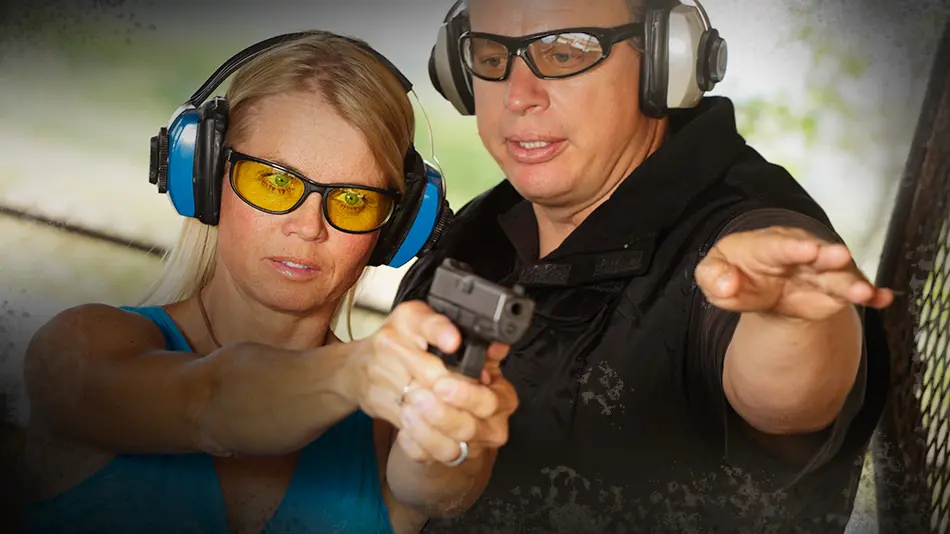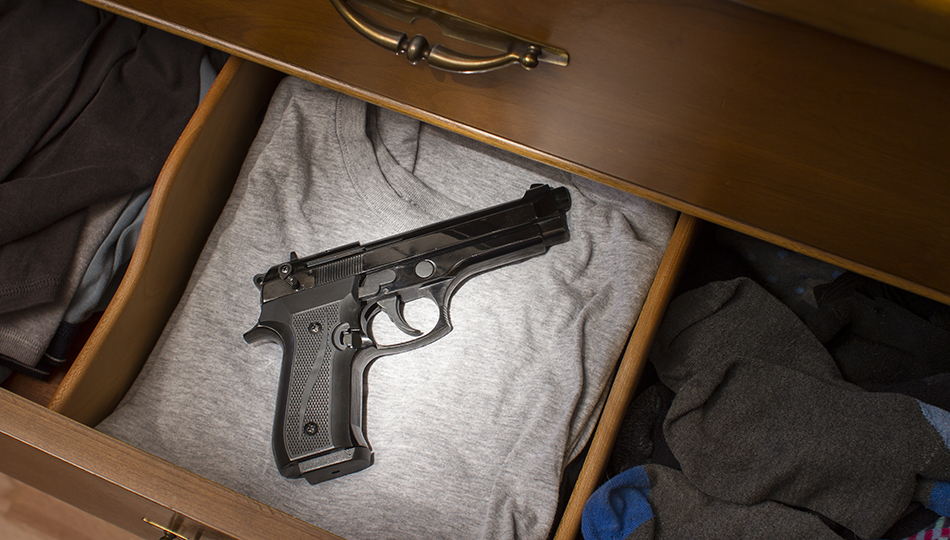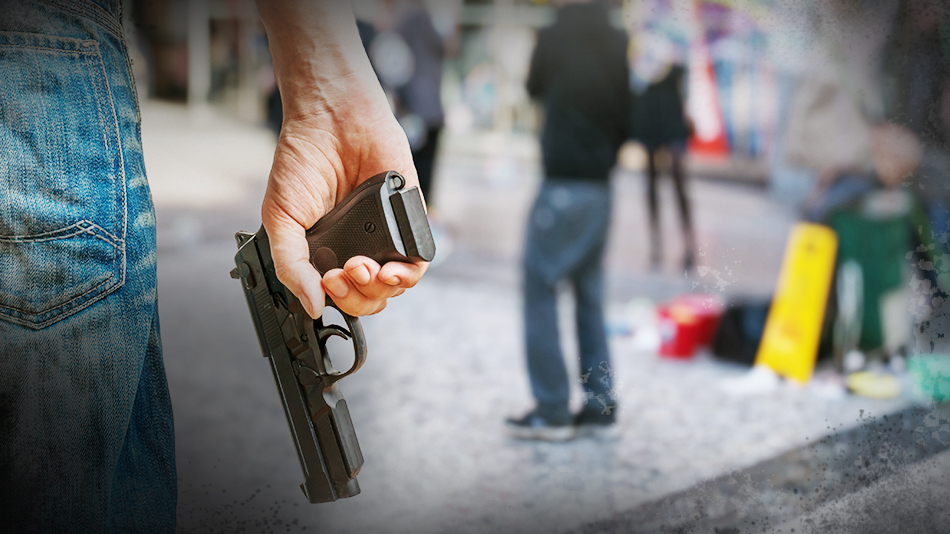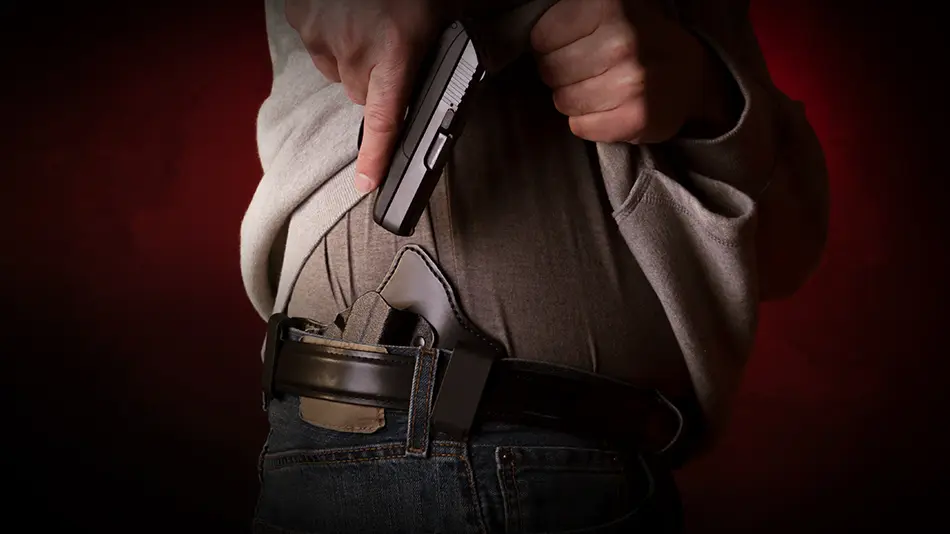
A “conceal and carry class” is a common term that generally refers to the class required before a person can obtain their license or permit to carry. However, it is important to keep in mind that the requirements for what a conceal and carry class must contain, or whether you even need to take a class to obtain your permit, vary depending on the state in which you live. So, while “conceal and carry class” is a common phrase, the phrase itself doesn’t tell us much about what is taught in most conceal and carry classes. With that in mind, we’ve decided to list the top 3 things we think the very best conceal and carry classes should cover.
Please keep in mind that this list is in no way exhaustive. Additionally, if your conceal and carry class didn’t cover some of these topics, that doesn’t mean you attended a bad class. Ultimately, part of being a responsibly armed gun owner is taking your education into your own hands and seeking as much knowledge and training as your resources allow. It can be difficult to get everything you need to know from just one class or source.
1. How to Carry a Gun
Thankfully, most people who choose to carry a gun will never have to use it in a self-defense encounter. But no matter the odds of actually needing your carry gun, being technically proficient with your carry gun is incredibly important given the stakes involved if you ever ARE forced to use it. Most importantly, you need to actually have the gun with you to defend yourself with it, and if you don’t know how to carry and conceal a firearm comfortably, the chances that you’ll have it with you to defend yourself go down.
With all that in mind, the best conceal and carry classes will teach you the things that you need to know so that you can conceal a gun on your person without negatively impacting your day-to-day life. This could include what to look for (and not look for) in a holster, the pros and cons of various carry methods, and, since we’re talking about the best conceal and carry class, a discussion on the principles of concealment.
2. How Things Can Go Wrong
Sadly, most people do not like examining ways that they might do something poorly. This is human nature and completely understandable. However, the best way to mitigate risk is to first acknowledge that the risk is present. With that in mind, the best conceal and carry class will include a conversation about how a self-defense encounter can go wrong and the risks that need to be mitigated by anyone who chooses to own or carry a gun for personal protection.
Specifically, there should be conversations about the potential aftermath of a self-defense shooting (so that people understand why it’s always better to avoid a violent encounter if at all possible) and about the rules of safe gun-handling and why it’s crucial that they must be treated as life rules, not just range rules. The best conceal and carry class might even include a conversation about legendary firearms trainer Claude Werner’s work regarding “Serious Mistakes Gunowners Make.”
3. Deadly Force and Use of Force Law
One of the most misunderstood aspects of conceal and carry specifically, and personal protection in general, is the fundamental law surrounding when someone is justified in using deadly force to defend their own life or the life of someone else. The best conceal and carry class will spend a great deal of time on this subject and go into more depth beyond a generic “you need to be in fear for your life.”
Complicating this point is that while the basic concepts can be relatively universal, self-defense laws can have small or sometimes large divergences depending on the state that you live in. With the caveat that it’s of the utmost importance that you familiarize yourself with your local laws, there are four general things to keep in mind when considering whether or not you would be justified to defend yourself with deadly force.
First, does the person you’re defending yourself against have the ability to cause you death or great bodily harm? It’s important to realize that someone’s ability to do you harm is not solely dependent on them being armed with a weapon. Disparities in size, age, overall physical ability, or even positioning can significantly impact someone’s ability to do you harm.
Second, even if someone has the ability to cause you death or great bodily harm, they must also have the opportunity to bring that ability to bear. For instance, someone armed with a knife can injure or kill. However, suppose our imaginary knife-wielding attacker is separated from approaching you by something like a chain-link fence. In that case, they do not have the opportunity to use that force against you. Put a gun in the hands of the same attacker, and now they have both ability and opportunity. Ability and opportunity alone are not enough, though, because there are two other points to consider.
Third, your life must be in imminent (immediate) danger or jeopardy, and you need to be able to reasonably articulate that fact both in the moment and after the event is over. Ability and opportunity on their own are not enough. Many of us go about our everyday life surrounded by people who have the ability and the opportunity to do us harm. Suppose two friends have lunch together, and both individuals carry a gun concealed on their person as a normal part of their lives. In that case, both individuals have the ability and opportunity to do each other harm. However, there is no jeopardy because neither party is doing anything to indicate that it’s anything other than a normal everyday interaction.
Contrast that with a stranger approaching you in a parking lot, who produces a weapon, and demands all of your money. In this instance, you can clearly articulate that your life is in immediate jeopardy. There’s one final point to consider, though, and it absolutely has to do with the defender’s actions.
The fourth and final point to consider is that, above all else, the defender must not have done anything to preclude their claim of self-defense. The preclusion concept can be harder for people who are new to self-defense to grasp, and the best conceal and carry class would absolutely take time to walk students through this concept. Many specific actions could preclude someone’s self-defense claim, but as a general rule, the most important part for our purposes is that the self-defender must not have provoked the interaction; i.e., been the initial aggressor, or caused the initial confrontation as a pretext to use force or deadly force.
The Best Conceal and Carry Class?
There are many other things that a candidate for “the best conceal and carry class” would include, and any one of these topics could be, and in some cases are, the basis of entire classes. It is impossible to fit everything that could be discussed in the best conceal and carry class into even an entire weekend of training, which is why it’s important that responsibly armed individuals always seek the highest level of training that their resources allow.
The information provided in this publication is intended to provide general information to individuals and is not legal advice. The information included in this publication may not be quoted or referred to in any other publication without the prior written consent of U.S. LawShield, to be given or withheld at our discretion. The information is not a substitute for, and does not replace the advice or representation of a licensed attorney. We strive to ensure the information included in this publication is accurate and current, however, no claim is made to the accuracy of the information and we are not responsible for any consequences that may result from the use of information in this publication. The use of this publication does not create an attorney-client relationship between U.S. LawShield, any independent program attorney, and any individual.





As a CCW instructor for the past 17 years, I was happy to see your thoughts on these topics and how my class integrates those subjects. I was very interested in Claude Werner’s work regarding “Serious Mistakes Gunowners Make.” But, the link to purchase the recording is gone. Any updated information as to how one might obtain the recording would be appreciated.
Keith – Claude is a good friend of mine. I suggest you try his website and reach out to him. I’m sure he will be able to help you out. The link is: https://tacticalprofessor.wordpress.com/ There is also a mailing address on the website if you wish to send him correspondence through the mail.
Very informative and helpful , thank you!
Thank you for reading!
“Imminent’ is not a synonym for “immediate” and it should not be used as such, particularly when discussing use of force law. They are two different things although ‘imminent’ does include “immediate” as a component. Some state laws specifically use the word “imminent” and others use the word “immediate.” “Immediate” means “right now” or “this second.” On the other hand “imminent” is a larger concept and certainly includes things that are “immediate,” but also includes other things.
Envision this scenario in a jurisdiction that specifically uses the word “imminent”: Someone breaks into your home at night, battering down the door or breaking a window. You go to see what happened and the individual produces a firearm and you use your firearm to defend yourself. After an exchange of gunfire the slide other person’s handgun locks back and your recognize that the person’s gun is now empty. The suspect turns and runs down a hallway in your house, but not in the direction of an exit. Can you shoot that suspect in the back?
The answer would unequivocally be yes. The question is why? Why can you do that when the person is clearly not an “immediate” threat to your life because his or her handgun is now unloaded? Well, I’ll ask you one more question…what are you trained to do when your handgun runs out of ammunition? Reload it, of course, and behind cover if possible. Is it reasonable for you to believe that this person is going to run around the corner at the end of the hallway, get behind the cover provided by the corner, and reload their handgun? The answer is yes. Why? Because everyone who runs out of ammunition in a gunfight is either trained to do so or does so because it’s common sense. So the threat they pose is “imminent,” the dictionary definition of which is “near at hand, impending,” or “Impending; menacingly close at hand; threatening.” Contrast this with the definition of “immediate,” which is “at once, without delay.”
So, for our purposes anything that is immediate is clearly imminent, but some things that are imminent are not immediate. The suspect in our hypothetical is clearly an “imminent” threat to run around the corner and reload and continue to then “immediately” threaten you, but that person is not an “immediate” threat because at this second “at once, without delay” their gun is not loaded. If you live in a jurisdiction where the law allows you to defend yourself using deadly force against an “imminent” threat of death or serious physical harm, you may clearly shoot the individual in the back.
Of course its important to note that one needs to ask an attorney in your jurisdiction what the law in that jurisdiction requires, but understand that imminent and immediate are two separate things regardless of whether or not they are commonly conflated by people who should know better.
Great analysis, clear illustration. Thanks a lot.
However… If there is no other member of my family is at that end of the corridor, I would probably not shoot the perp in the back – of course, if I manage to think about it, not act on pure emotion and adrenalin. Could prosecutor’s argument be ‘If he needs time to reload, you have time to run to the phone’? Even with the Castle Doctrine, if it can be calculated that without the “immediate” (this very second!) danger to my life, with my gun still in my hand I had enough time to grab the phone, hid myself the same way as the perp behind the other corner and call the cops, could it be construed that I did have a chance to save his life?
It is VERY IMPORTANT to read and think about the various situations as we all know things happen in an instant when we have little time to think. This is great info to read. Thanks for sending out the information we need to remember every time we carry a gun.
Thanks for the comment, Phil! We are glad you are enjoying the content and thank you for your support.
Im73years old I have a small 380 love it naver shot it ,all the shooting ranges were closed when the virus came out do you think I need a license and do you think I’m too old to get one my name is Dorothy
I can’t speak on needing a license – that varies by state, but any local shooting range should be able to tell you what your state’s laws are. If you’ve never shot before, I would recommend some type of beginner class – the NRA “First Steps” classes are offered many places for beginners to become familiar with using their firearms safely. As for age, as long as you can see & handle your .380 and are of sound mind there shouldn’t be any problem. My father was still going to the range with me until shortly before he passed at 73 and I’ve had older friends well over 70 still shooting regularly.
I liked it when you said that a “conceal and carry class” is a common term that generally refers to the class required before obtaining their license or permit to carry. My wife wants to learn to shoot and make firearm shooting a hobby. I will enroll her in a firearm class for her to acquire a license and fulfill her wish. Thanks for the help of this post.
I thought I’d share from my experiences. The basic concealed carry class I took spent the vast majority of the class on state use of force laws & where you can/can’t legally carry concealed. A few times as state laws have changed, my local range has offered short “refresher” classes to address the changes for anyone interested. The range portion was quick and nearly pointless – requiring 35/50 hits on a half silhouette at 3, 5 & 7 yards. I shot half the course left handed to make it more interesting. Then I turned in all my paperwork, went through the wait & got my carry permit. And suddenly, I can now carry a handgun concealed in public. Except I’ve never done that before, and the class didn’t really cover even a little bit of it. I had plenty of friends that shot & already had their carry permits, so I had a pretty good idea on holster type, carry position, etc that I thought would work for me. But there are no ranges around me that allow drawing from a holster on the range. My normal range did however offer a “Combat Practical Handgun” single day class. About 2 hours of classroom followed by several hours & several hundred rounds on the range. Drawing from a holster, target ID, shoot/no-shoot decisions, accurate rapid fire. The final part of the class, one at a time we lined up, weapons holstered & the instructors would call out a lane number, we ran to the lane – with instructors yelling to distract & add stress, turned onto the correct lane, identified the target, and if appropriate drew & shot. Rinse & repeat until we’d all covered most or all of the lanes. It was an invaluable class and anyone who carries or plans to use a firearm for home defense should look into if any local ranges offer something similar. I’ve never had to fire my handgun in anger but I had to draw it once to stop an attempt to kidnap my wife while walking our dogs – I was about 20′ away in a field while she was on the sidewalk. From when I saw the threat until they drove off, everything went back to the practical training class. About halfway through my draw the passenger saw me & jumped back in the car, ending the threat. But there was no worrying about what to do – and there was no time for it – it all goes back to your training.
I found it interesting when you said that a conceal and carry class will teach you to what to look for and not to look for in a holster and in other stuff. This is something that I will share with my husband because he wants to shop for a gun before the month ends. He usually works at night, so he wants to ensure that he can protect himself from criminals. Thanks for sharing this.
Hi there. My friend’s nephew intends to become a police officer once he graduates this autumn. I found it quite helpful when you explained that a sensible risk assessment is crucial so we won’t misuse our weapon towards innocent bystanders. I’ll remind him about this matter so he can be a responsible gun carrier later.
Thanks for pointing out that you would learn the pros and cons of various carry methods when you attend a concealed carry course. I will share this with my husband so he can consider attending a CCW class next week. He is planning to apply for a permit in order to be able to carry a gun with him for self-defense purposes, so it is essential for him to understand the important things about carrying one.